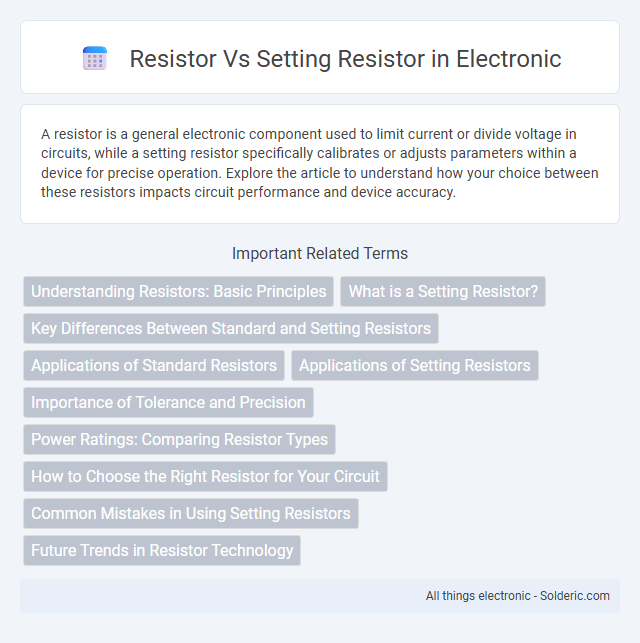A resistor is a general electronic component used to limit current or divide voltage in circuits, while a setting resistor specifically calibrates or adjusts parameters within a device for precise operation. Explore the article to understand how your choice between these resistors impacts circuit performance and device accuracy.
Comparison Table
| Feature | Resistor | Setting Resistor |
|---|---|---|
| Definition | Passive electrical component limiting current flow. | Resistor used to set specific operating conditions in a circuit. |
| Function | Controls current, voltage division, and signal conditioning. | Establishes reference currents or voltages in devices and circuits. |
| Application | General use in circuits for current limiting and biasing. | Precise adjustment of circuit parameters like gain or offset. |
| Value Tolerance | Varies widely (1% to 20% common). | Typically high precision (<=1% tolerance). |
| Example | Current limiting resistor in LED circuit. | Setting resistor for operational amplifier gain. |
Understanding Resistors: Basic Principles
Resistors limit electric current flow by providing precise resistance measured in ohms, essential for controlling voltage and protecting components. Setting resistors, often adjustable like potentiometers or variable resistors, allow you to fine-tune circuit parameters for specific applications. Understanding these basic principles ensures accurate circuit design and optimal device performance.
What is a Setting Resistor?
A setting resistor is a specialized type of resistor used to configure or adjust the output parameters of electronic devices such as current regulators or voltage controllers. Unlike standard resistors that primarily limit current or divide voltage, setting resistors define specific operational points by establishing reference currents or voltages in circuits. These components are critical for precision control in applications like LED drivers, power supplies, and sensor calibration systems.
Key Differences Between Standard and Setting Resistors
Standard resistors provide a fixed resistance value used primarily for voltage division or current limiting in circuits. Setting resistors, often adjustable or precision components, enable fine-tuning of electrical parameters to achieve specific performance characteristics. Key differences include their roles in circuit design, with standard resistors offering stability and setting resistors allowing customization for calibration or sensitivity adjustments.
Applications of Standard Resistors
Standard resistors provide consistent resistance values essential for precise voltage division, current limiting, and signal conditioning in electronic circuits. Unlike setting resistors, which are adjustable for calibration and tuning, standard resistors ensure stability and repeatability in applications such as biasing transistors, setting gain in amplifiers, and defining timing intervals in oscillators. Their fixed resistance values make them reliable components for mass-produced devices requiring uniform performance.
Applications of Setting Resistors
Setting resistors are primarily used in electronic circuits to precisely control current flow, voltage levels, and timing intervals. These components are essential in applications such as adjustable power supplies, LED current regulation, and sensor calibration, where accurate resistance values determine device performance. Unlike general-purpose resistors, setting resistors are carefully selected or trimmed to achieve specific electrical characteristics critical for circuit stability and accuracy.
Importance of Tolerance and Precision
Resistor tolerance directly impacts the accuracy and reliability of your circuit, as it defines the permissible deviation from the nominal resistance value. Setting resistors require high precision and low tolerance to ensure exact voltage or current control in sensitive applications like voltage dividers or reference circuits. Choosing resistors with appropriate tolerance levels enhances circuit stability and performance by minimizing variations caused by manufacturing inconsistencies or environmental factors.
Power Ratings: Comparing Resistor Types
Power ratings in resistors vary significantly depending on the type and construction, affecting their performance in different circuits. Standard fixed resistors typically have power ratings ranging from 0.125W to 5W, while wirewound resistors can handle higher power levels, often exceeding 10W, making them suitable for high-power applications. When selecting a resistor for your circuit, consider the power dissipation requirements carefully to ensure reliability and prevent overheating.
How to Choose the Right Resistor for Your Circuit
Choosing the right resistor for your circuit involves understanding its resistance value, power rating, and tolerance to match the electrical requirements precisely. A setting resistor, often used in configurable components like voltage regulators or current limiters, must be selected based on the specific set point needed for correct operation. Consider the operating voltage, allowable power dissipation, and environmental conditions to ensure reliability and efficiency in your circuit design.
Common Mistakes in Using Setting Resistors
Common mistakes in using setting resistors include selecting incorrect resistance values, which can lead to improper current regulation and potential component damage. Misplacing the setting resistor in the circuit or poor soldering connections often cause unreliable performance or fluctuating output levels. Ensuring your setting resistor matches the specified tolerance and power rating prevents these issues and maintains circuit stability.
Future Trends in Resistor Technology
Resistor technology is evolving with advancements in materials such as graphene and metal oxides, enhancing precision and thermal stability beyond traditional carbon film and metal film resistors. Setting resistors, crucial in adjustable circuits, are benefiting from developments in digital potentiometers and programmable resistors, enabling real-time resistance adjustments with improved accuracy and reduced power consumption. Future trends emphasize miniaturization, integration with smart sensors, and enhanced reliability to meet demands in IoT, automotive electronics, and wearable devices.
resistor vs setting resistor Infographic

 solderic.com
solderic.com